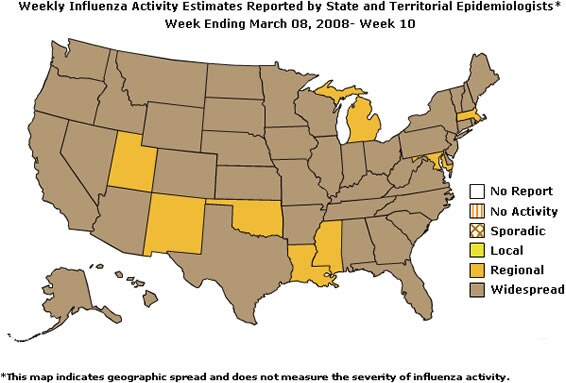Error processing SSI file
Weekly Report: Influenza Summary Update
2007-2008 Influenza Season Week 10, ending March 8, 2008
(All data are preliminary and may change as more reports are received.)Synopsis
During week 10 (March 2 - 8, 2008), influenza activity continued to decrease in the United States.
- One thousand nine hundred thirty-six (21.6%) specimens tested by U.S. World Health Organization (WHO) and National Respiratory and Enteric Virus Surveillance System (NREVSS) collaborating laboratories were positive for influenza.
- The proportion of deaths attributed to pneumonia and influenza was above the epidemic threshold for the ninth consecutive week.
- The proportion of outpatient visits for influenza-like illness (ILI) was above national baseline levels, while the proportion of outpatient visits for acute respiratory illness (ARI) was below national baseline levels. ILI decreased in eight of the nine regions compared to week 9, and fell below the region specific baseline in the Mid-Atlantic region, but remained above region-specific baselines in the remaining eight regions. The West North Central region reported ARI above its region-specific baseline.
- Forty-two states reported widespread influenza activity; eight states reported regional influenza activity; the District of Columbia reported local influenza activity; and Puerto Rico reported sporadic influenza activity.
Region |
Data for current week | Data cumulative for the season | |||||||
|---|---|---|---|---|---|---|---|---|---|
| Sentinel Provider ILI* | DoD and VA ARI* | % pos. for flu† | # jurisdictions reporting regional or widespread activity‡ | A (H1) | A (H3) | A Unsub-typed | B | Pediatric Deaths | |
| Nation | Elevated | Normal | 21.6 % | 50 of 51 | 1738 | 4209 | 15432 | 5909 | 41 |
| New England | Elevated | Normal | 26.0 % | 6 of 6 | 78 | 84 | 689 | 640 | 2 |
| Mid-Atlantic | Normal | Normal | 28.1 % | 3 of 3 | 165 | 200 | 788 | 938 | 7 |
| East North Central | Elevated | Normal | 44.4 % | 5 of 5 | 151 | 988 | 553 | 319 | 6 |
| West North Central | Elevated | Elevated | 26.5 % | 7 of 7 | 71 | 102 | 2061 | 639 | 4 |
| South Atlantic | Elevated | Normal | 30.6 % | 8 of 9 | 303 | 1411 | 3992 | 1034 | 4 |
| East South Central | Elevated | Normal | 43.3 % | 4 of 4 | 31 | 579 | 87 | 34 | 5 |
| West South Central | Elevated | Normal | 26.9 % | 4 of 4 | 103 | 426 | 5656 | 1129 | 6 |
| Mountain | Elevated | Normal | 22.4 % | 8 of 8 | 389 | 292 | 845 | 713 | 3 |
| Pacific | Elevated | Normal | 15.3 % | 5 of 5 | 447 | 127 | 761 | 463 | 4 |
* Elevated means the % of visits for ILI or ARI is at or above the national or
region-specific baseline
?National data is for current week; regional data is for the most recent 3 weeks.
?Includes all 50 states and the District of Columbia
Laboratory Surveillance
During week 10, WHO and NREVSS laboratories reported 8,969 specimens tested for influenza viruses, 1,936 (21.6%) of which were positive, including 19 influenza A (H1) viruses, 183 influenza A (H3) viruses, 1,026 influenza A viruses that were not subtyped, and 708 influenza B viruses.
Since September 30, 2007, WHO and NREVSS laboratories have tested a total of 152,746 specimens for influenza viruses and 27,288 (17.9%) were positive. Among the 27,288 influenza viruses, 21,379 (78.3%) were influenza A viruses and 5,909 (21.7%) were influenza B viruses. Five thousand nine hundred forty-seven (27.8%) of the 21,379 influenza A viruses have been subtyped: 1,738 (29.2%) were influenza A (H1) viruses and 4,209 (70.8%) were influenza A (H3) viruses.
Although influenza A (H1) viruses predominated through mid-January, an increasing proportion of subtyped influenza A viruses are influenza A (H3) viruses. Influenza A (H3) viruses have been reported more frequently than influenza A (H1) viruses since week 4 (January 20-26), and during week 6 (February 3-9), influenza A (H3) became the predominant virus for the season overall. This season influenza A (H3) viruses have been reported more frequently than A (H1) viruses nationally, as well as in seven of the nine surveillance regions (East North Central, East South Central, Mid-Atlantic, New England, South Atlantic, West North Central, and West South Central). Influenza A (H1) viruses have predominated circulation this season in the remaining two regions (Mountain and Pacific).
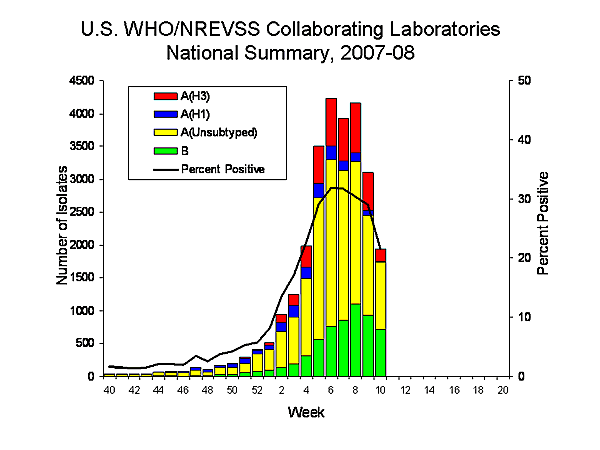
View WHO-NREVSS Regional Bar Charts | View Chart Data | View Full Screen
Composition of the 2008-09 Influenza Vaccine:
WHO and FDA have recommended that the 2008-09 trivalent influenza vaccine for the Northern Hemisphere contain A/Brisbane/59/2007-like (H1N1), A/Brisbane/10/2007-like (H3N2), and B/Florida/4/2006-like viruses. All three components have been changed from the 2007-08 Northern Hemisphere vaccine formulation. A/Brisbane/10/2007-like (H3N2) and B/Florida/4/2006-like viruses are currently included in the 2008 Southern Hemisphere vaccines. This recommendation was based on surveillance data related to epidemiology and antigenic characteristics, serological responses to 2007-08 vaccines, and the availability of candidate strains and reagents.
Antigenic Characterization:
CDC has antigenically characterized 425 influenza viruses [191 influenza A (H1N1), 107 influenza A (H3N2), and 127 influenza B viruses] collected by U.S. laboratories since September 30, 2007.
Influenza A (H1) [191]
- One hundred forty-seven (77%) of the 191 viruses were characterized as A/Solomon Islands/3/2006-like, the influenza A (H1N1) component of the 2007-08 influenza vaccine for the Northern Hemisphere and the 2008 influenza A (H1N1) component for the Southern Hemisphere.
- Nineteen (10%) of the 191 viruses showed somewhat reduced titers with antisera produced against A/Solomon Islands/3/2006.
- Twenty-five (13%) of the 191 viruses were characterized as A/Brisbane/59/2007-like. A/Brisbane/59/2007 is a recent genetic/antigenic variant which evolved from A/Solomon Islands/03/2006. An A/Brisbane/59/2007-like virus is the WHO recommended strain for the 2008-09 Northern Hemisphere vaccine formulation.
Influenza A (H3) [107]
- Twenty (19%) of the 107 viruses were characterized as A/Wisconsin/67/2005-like, the influenza A (H3N2) component of the 2007-08 influenza vaccine for the Northern Hemisphere.
- Eighty (75%) of the 107 viruses were characterized as A/Brisbane/10/2007-like. A/Brisbane/10/2007-like viruses are a recent antigenic variant which evolved from, but are antigenically distinct from, A/Wisconsin/67/2005-like viruses. A/Brisbane/10/2007-like virus is the recommended influenza A (H3N2) component for the 2008 Southern Hemisphere and 2008-09 Northern Hemisphere vaccines.
- Seven (6%) of the 107 viruses showed somewhat reduced titers with antisera produced against A/Wisconsin/67/2005 and A/Brisbane/10/2007.
Influenza B (B/Victoria/02/87 and B/Yamagata/16/88 lineages) [127]Victoria lineage [7]
- Seven (6%) of the 127 influenza B viruses characterized belong to the B/Victoria lineage of viruses.
o Five (71%) of these 7 viruses were characterized as B/Ohio/01/2005-like. The recommended influenza B component for the 2007-08 influenza vaccine is a B/Malaysia/2506/2004-like virus, belonging to the B/Victoria lineage. B/Ohio/01/2005 is a recent B/Malaysia/2506/2004-like reference strain.
o Two (29%) of these 7 viruses showed somewhat reduced titers with antisera produced against B/Ohio/01/2005 and B/Malaysia/2506/2004.Yamagata lineage [120]
- One hundred twenty (94%) of the 127 influenza B viruses characterized belong to the B/Yamagata lineage of viruses.
o One hundred nineteen (99%) of these 120 viruses were identified as B/Florida/04/2006-like, the recommended influenza B component for the 2008-09 Northern Hemisphere vaccine formulation.
o One (1%) of these 120 viruses showed a somewhat reduced titer with antiserum produced against B/Florida/04/2006.
These data indicate similarities and differences between a sample of circulating strains and this year's vaccine strains as determined by laboratory studies. Clinical vaccine effectiveness cannot be accurately predicted using these data, and in previous years, influenza vaccination has been shown to provide measurable protection against influenza illness and influenza-related complications, even when vaccine strains are antigenically distinct from circulating strains.
Antiviral Resistance:
In the United States, two groups of antiviral drugs have been approved by FDA for use in treating or preventing influenza virus infections. These two groups of antiviral drugs are: neuraminidase inhibitors (oseltamivir and zanamivir) and adamantanes (amantadine and rimantidine). A description of these drugs can be found at: http://www.cy118119.com/flu/protect/antiviral/index.htm.
Neuraminidase Inhibitor Antiviral Drugs: So far this season, 793 influenza A and B viruses from the United States have been tested for antiviral resistance. 51 (7.3%) of 696 influenza A viruses tested, and 0 (0.0%) of 97 influenza B viruses tested have been found to be resistant to oseltamivir. Currently all of the resistant viruses are H1N1 viruses, with 51 (9.1%) of 561 H1N1 viruses tested exhibiting a genetic mutation that confers oseltamivir resistance. All tested viruses retain their sensitivity to zanamivir. Additional information on antiviral resistance can be found at: http://www.cy118119.com/mmwr/preview/mmwrhtml/rr5606a1.htm
Adamantane Antiviral Drugs: Resistance to the adamantanes continues to be high among influenza A (H3N2) viruses with 107 (99.1%) of 108 influenza A (H3N2) viruses tested resistant to the adamantanes. Adamantane resistance among influenza A (H1N1) viruses has also be detected but at a lower level. Of 467 influenza A (H1N1) viruses tested, 41 (8.8%) were resistant to the adamantanes. Since late January, influenza A (H3N2) viruses have predominated in the United States and during week 10, 90.6% of influenza A viruses subtyped were A (H3N2). The adamantanes are not effective against influenza B viruses.
Based on the level of oseltamivir resistance observed in only one influenza subtype, H1N1, persisting high levels of resistance to the adamantanes in H3N2 viruses, and the predominance of H3N2 viruses circulating in the United States during the 2007-08 season, CDC continues to recommend the use of oseltamivir and zanamivir for the treatment or prevention of influenza. Use of amantadine or rimantadine is not recommended. Guidance on influenza antiviral use can be found at: http://www.cy118119.com/mmwr/preview/mmwrhtml/rr5606a1.htm
Pneumonia and Influenza (P&I) Mortality Surveillance
During week 10, 8.7% of all deaths reported through the 122 Cities Mortality Reporting System were reported as due to P&I. This percentage is above the epidemic threshold of 7.2% for week 10. Including week 10, P&I mortality has been above epidemic threshold for nine consecutive weeks.
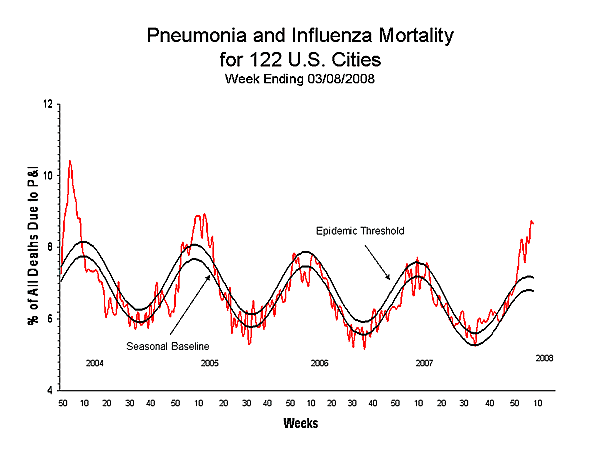
View Full Screen
Influenza-Associated Pediatric Mortality
Eight influenza-associated pediatric deaths were reported to CDC during week 10 [ME, MA, NJ, NM, PA(2), VA, and WI]. These deaths occurred between February 15 and March 2, 2008. One additional death from Illinois, confirmed during week 9, was not reported last week. Since September 30, 2007, CDC has received a total of 41 reports of influenza-associated pediatric deaths that occurred during the current season.
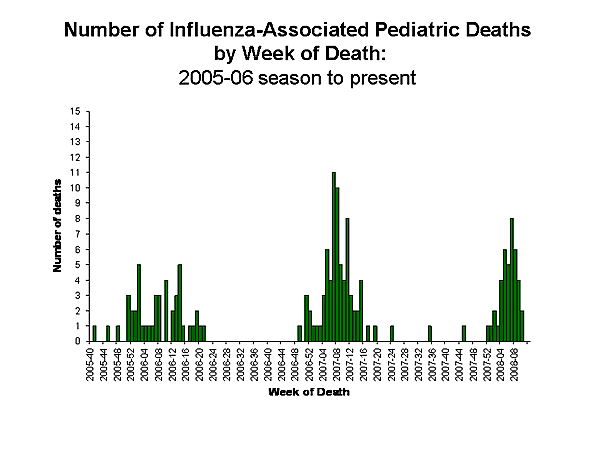
View Full Screen
Influenza-Associated Pediatric Hospitalizations
Laboratory-confirmed influenza-associated pediatric hospitalizations are monitored in two population-based surveillance networks: the New Vaccine Surveillance Network (NVSN) and the Emerging Infections Program (EIP). These two systems provide updates of surveillance data every two weeks. As a result of differing dates for initiating surveillance in the 2007-08 season, these updates occur on alternating weeks.
During November 4, 2007-February 23, 2008, the preliminary laboratory-confirmed influenza-associated hospitalization rate reported by the NVSN for children 0-4 years old was 3.48 per 10,000.
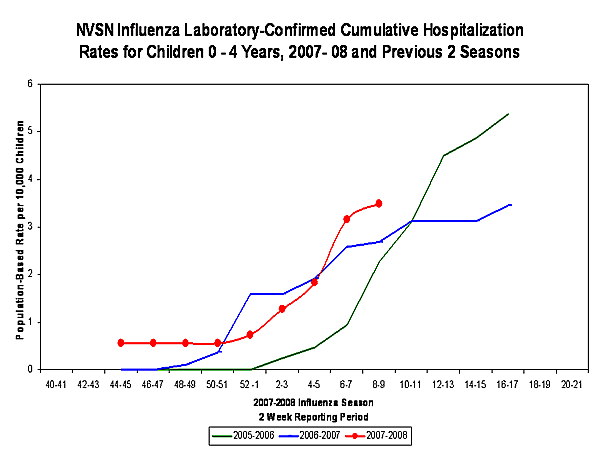
View Full Screen
During September 30 ?March 1, 2008, the preliminary laboratory-confirmed influenza-associated hospitalization rate reported by the EIP for children 0?7 years old was 0.85 per 10,000. For children aged 0-4 years and 5-17 years, the rate was 2.20 per 10,000 and 0.29 per 10,000, respectively.
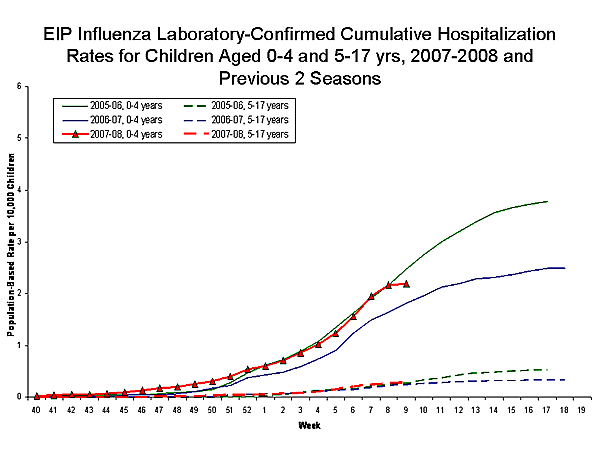
View Full Screen
Outpatient Illness Surveillance
Nationwide during week 10, 4.0% of outpatient visits reported through the U.S. Influenza Sentinel Provider Surveillance Network were due to influenza-like illness (ILI), which is above the national baseline of 2.2%. On a regional level, the percentage of visits for ILI decreased in eight of the nine regions compared to week 9 and ranged from 2.7% to 6.5%. Eight of the nine regions reported ILI above their region-specific baselines (East North Central, East South Central, Mountain, New England, Pacific, South Atlantic, West North Central, and West South Central).
During week 10, 3.0% of patient visits to Department of Veteran抯 Affairs (VA) and Department of Defense (DoD) outpatient treatment facilities were for acute respiratory illness (ARI), which was below the national baseline of 3.2%. On a regional level, the percentage of visits for ARI ranged from 1.6% to 3.5%, and was at or above the region-specific baselines in one of the nine regions (West North Central). The percentage of visits reported for ARI was at or above age-specific baselines in the 5-17 years and 50-64 years age groups.
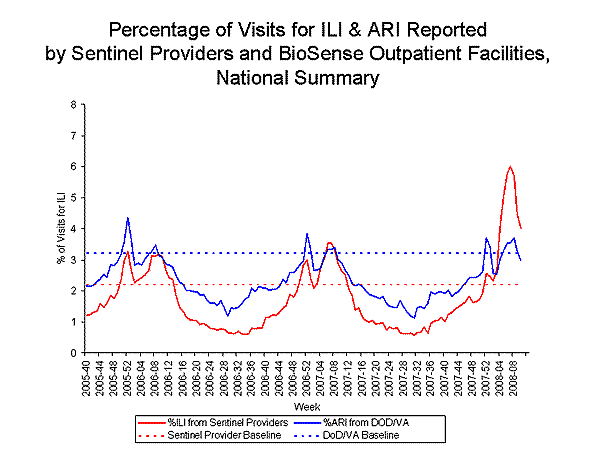
View Sentinel Providers Regional Charts | View Chart Data |View Full Screen

View Full Screen
Geographic Spread of Influenza as Assessed by State and Territorial Epidemiologists
During week 10 the following influenza activity was reported:
- Widespread activity was reported by 42 states (Alabama, Alaska, Arizona, Arkansas, California, Colorado, Connecticut, Delaware, Florida, Georgia, Hawaii, Idaho, Illinois, Indiana, Iowa, Kansas, Kentucky, Maine, Minnesota, Missouri, Montana, Nebraska, Nevada, New Hampshire, New Jersey, New York, North Carolina, North Dakota, Ohio, Oregon, Pennsylvania, Rhode Island, South Carolina, South Dakota, Tennessee, Texas, Vermont, Virginia, Washington, Wisconsin, West Virginia, and Wyoming).
- Regional activity was reported by eight states (Louisiana, Maryland, Massachusetts, Michigan, Mississippi, New Mexico, Oklahoma, and Utah).
- The District of Columbia reported local influenza activity.
- Puerto Rico reported sporadic influenza activity.
--------------------------------------------------------------------------------
A description of surveillance methods is available at: http://www.cy118119.com/flu/weekly/fluactivity.htm
- Page last updated March 14, 2008. Error processing SSI file
